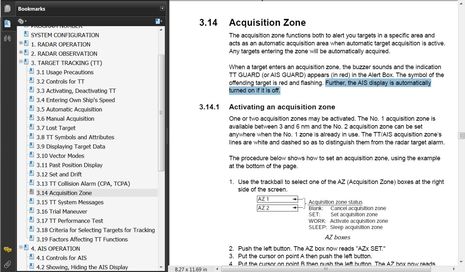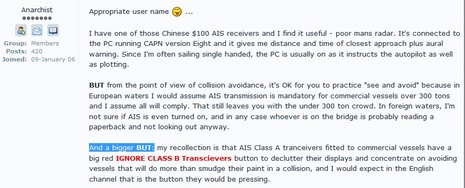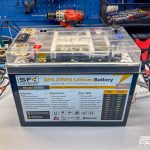Steve Dashew’s IMO radar, an AIS myth resurfaces
Oh my. This morning an email alerted me to this photo of an AIS Display Filter menu on a Furuno IMO-class FAR-2117 radar, and Steve Dashew’s understandable misunderstanding of what it means. The seductive myth that ships have the technology to completely ignore Class B AIS transponders is back! And the comments that follow demonstrate just how destructive that myth is, like: “Wow. That is really disturbing. I am sure it is something that the
manufacturers of Class B transceivers don’t want us to know. I have been
waiting for the Vesper Marine transceiver to become available – I might
opt for the receive only unit now and save some $$$.” Here’s the truth: No matter how that display filter is set, the 2117 radar will continue to track all AIS targets and will automatically display a filtered one — in flashing red, with a buzzer, even! — if it should enter the watch keeper’s area of collision concern, which is exactly how the IMO intends to improve big ship AIS monitoring!…
Back in early 2009 I got a copy of the IEC specifications for big ship radar/AIS display and wrote an entry called AIS SOLAS-style, Class B is NOT ignorable! (Yes, I get worked up about this subject 😉 Today I downloaded the manual for the IMO version of Furuno FAR2xx7 radar, which you’ll see listed here, and, no surprise really, it conforms closely to the IEC spec. The key phrase is seen below in the manual’s section about the Acquisition Zones where radar targets are automatically acquired. ARPA, as you probably know, is the key feature of ship radars and traditionally the primary tool watch keepers use to avoid collisions. So “When a target enters the acquisition zone…the AIS display is automatically turned on if it is off” not only means that the worry about ignoring Class B vessels is unfounded but that IMO is raising AIS target status — be it A or B — to ARPA level.
Remember that previously there was no mandated graphical AIS target tracking on ship
bridges, because the display that comes with Class A Transponders is
only required to list targets in text. But I think that radars like Steve’s are now required on all new SOLAS vessels and will be mandated on older boats eventually, so what he’s actually looking at, beyond the confusing display menu, is an improvement in IMO level AIS tracking. But the idea that ships can, or would, ignore Class B transponders is incredibly persistent, as we saw again last April, and as I wrote about last summer in Cruising World. And if I’ve misunderstood what’s going on here, please don’t hestitate to correct me; this is important stuff.
PS Thanks to some Panbo readers who were more diligent about reading the Furuno manual than I was, it appears that there is a way to filter out even dangerous AIS targets by their equipment classification or vessel size (see comments below). It takes some doing, and I doubt it will be done often, especially outside crowded harbors, but I’ll take that up in another entry soon. Update here.














Ben, just wondering why you wouldn’t have left a comment there debunking this? Clicking on your link through to Dashew’s site all I see are comments from folks who see oddly eager to believe this…
I did that first thing, Graham, but it hasn’t been approved for display yet. I think Steve may be traveling, now that Wind Horse is in Ft. Lauderdale.
Ben, reading through the manual I don’t think this is necessarily settled. It does state that hidden targets are still being tracked. However, the display of the target when it becomes critical seems to be based on proper setup of the radar acquisition zone or CPA range. It seems that the radar acquisition zone need not be set at all, and I’m unclear about the minimum CPA limit from this language:
The AIS continuously monitors the predicted range at the Closest Point of
Approach (CPA) and predicted time to CPA (TCPA) of each AIS target. When the
predicted CPA of an AIS target becomes smaller than a preset CPA range and its
predicted TCPA less than a preset TCPA limit, the audio alarm sounds and AIS
COLLISION appears (in red) in the Alert Box. In addition, the symbol of the
offending AIS target is red and flashes together with its vector.
Of course, if the SOLAS vessel’s radar is functioning properly your boat should show up on their radar regardless of whether or not your AIS is filtered.
Would be great to have someone run some actual tests to see how this works in the real world, or have Furuno Tech weigh in.
/afb
Hi Adam, I have asked Furuno to comment. Thanks for pointing out that crossing the CPA/TCPA alarm thresholds also causes the AIS display to be turned on (Section 3.13.2). So that’s two ways a filtered target can get displayed, collision alarm and ARPA zone, with no differences allowed for radar and AIS settings. In the real world, I’m pretty sure both of those are used heavily by ships.
The bigger picture, of course, is that ship drivers are generally trying to avoid colliding with anything. I think it’s wrong headed to think they would purposely ignore transponders if they could, or that the IMO would give them tools to do that.
Ben;
I made the offending comment you quoted here from the Dashew’s site. I feel like somebody who just forwarded on an urban legend via email to all of my contact list ;
Thanks, Chris! And I feel like the obnoxious guy who responds to those emails with a Snopes link. Which I do regularly, can’t seem to help myself 😉
Also, the good Steve Dashew did approve one of my comments at SetSail from an airport somewhere, and also let me know that he hope’s I right.
From my (admittedly limited) understanding of the requirements, Ben, you are correct that the display filters do not stop the unit from receiving and tracking class B signals. The filter settings should just suppress these icons on the display until the computer decides they are too great a hazard to ignore.
Consider, though, the case of a less-than-professional watchkeeper on a big freighter, with certain types of AIS targets suppressed on his screen. He will think there’s nothing to worry about, even though there may be several smaller craft nearby. The professional captain will figure this out and adjust the settings. The bloke who bought his certs off the ‘Net would, if targets weren’t suppressed, get worried and perhaps call his superior. But if he doesn’t see anything, and waits for the alarm, it could very well be too late.
Yes, there are situations where display filters could help clean up a screen. Does that mean it’s a good idea to have them? I’d say no, at least not unless the system offers some kind of impossible-to-ignore warning that “Small vessels are not visible with these settings”.
Matt, you seem to be imagining a vessel where the bridge crew is sophisticated enough to apply AIS display filtering, which is off by default, but also dumb enough to turn off guard zones and CPA alarms, which are on by default (I’m pretty sure). Seems unlikely.
While I hope that large vessels cannot filter out Class B data, I am considering filtering it out of the feed to my E-80. It is quite annoying when a small power boat on a parallel course repeatedly triggers an alarm. Considering that a very low percentage of small vessels have AIS transceivers there would be essentially zero loss of safety, I have to watch for these vessels visually at all times anyway. I should point out that I sail in daylight, on Chesapeake Bay, rarely in bad weather.
My slip is close enough to the shipping channel that I get AIS alarms while in the slip with the electronics on (working on N2k tests, or something). I’m happy to run to the cockpit to silence the alarm and watch the big car carrier pass, but less happy when it is a small boat that I cannot even see.
With improved alarm algorithms this will be less of a problem, but I can imagine Class B alarm overload as the Class B transceiver population increases and the simple guard zone is all that we have.
I would, of course, remove any filtering in bad weather, offshore, etc.
Jon (preparing to duck after starting a new twist on the controversy…)
In response to JonM’s comment, I agree.
I’d love to see a software update from Ray, Garmin, Etc to have an “auto-silence” around a set waypoint, such as your home slip. Then when you move away from that waypoint, say 0.25nm, the AIS alarms re-arm automatically.
Right now, the Class-B AIS units don’t know that you’re tied to a dock: with an SOG of close to 0, they just assume you are anchored or adrift (and therefore still transmit and trigger alarms). It’s a real pain working on a system in NY harbor (where we have AIS transceivers a-plenty), and if I turn off the alarms while working, I better be darn sure I turn them back on when I’m done!!
I too have asked for and would LOVE to see a user definable “Mute” switch allowing users to silence AIS for say 5-10 minutes, or 15 minutes but not an hour…Consider the following from a few weeks ago.
Entering the Pax river headed to Zahniser’s after dark we were tailed by two Coastie RIBS from just after Drum Point alllllll the way to the dock. By that I mean two AIS targets, less than a boat length away, dead astern for 30 minutes or so. I am sure they were practicing firing solutions on us or something really important – but I had no way of telling the AIS to shut the hell up for a set period of time. I believe in the technology, just not crazy about the current implementation… SI is a busy place and it would be nice to be able to silence alarms for a fixed period of time, and then come back on.
Otherwise knowledgeable users are forced to kill all alarms and hope they remember to turn it back on the next time.
My last 2 ships had new radars installed and both had the same option. The good news is that receiving Class B transmissions was turned on by default on both units and a informal survey of the watchofficers relieved that each one either did not know much about Class B (and therefore didn’t dare touch the setting) or welcomed the additional information.
In full disclosure I believe enough in the technology that I, just last week, installed a Camino Class B transponder I purchased from Milltech marine and consider it a first line of defense in avoiding large ships which, from experience, I believe to be a real threat to safety when sailing offshore.
Ben,
One other item of concern in the manual for the FAR 28×7 series is in section 4.12.3, which gives the parameters for limiting the function of the collision alarm of the radar. This clearly DOES include an option to:
“EXCEPT CLASS B: Select ON to prevent automatic activation of class B
AIS targets.”
I don’t feel this is a settled issue at all, and it appears that Furuno has made a number of provisions to allow ship radar users to ignore Class B AIS users up to and including the triggering of collision alarms.
You’re right, Preston, unfortunately! That section, which I had missed yesterday, was pointed out to me by Panbo reader (and Wayfarer Marine electronics guru) John Gass this morning. I’ve been trying to dig deeper, so as not to cause further confusion, but that damn manual is a brain twister, and so far Furuno hasn’t directly answered my questions. Now I’m trying to get Andy Norris, a world-class expert on IMO-level electronics, to clarify this business.
It would be nice to know if the silence on this topic is related to the holidays or because it has proven impossible to get those “in the know” to comment on the record about this topic.
Hi Brian, I have not gotten a definitive answer from Furuno but I now suspect that if a watchkeeper applied a Class B display filter as shown in the top image, and did not set up an automatic acquisition zone that would force activation of such filtered targets, and also applied the Class B collision alarm filter that Preston spotted…well then his or her ship could run right over a Class B vessel without seeing it on their radar.
Of course the target still would have showed up on the MKD display of the ship’s Class A transponder, which by law has no filtering. And the ship might be in serious trouble. And it seems highly unlikely that a watchstander good enough with radar controls to apply all those non default settings would also be a careless watchstander.
At any rate, I did get a thorough response from Dr. Andy Norris, who knows more about this overall subject than anyone else I can think of:
https://panbo.com/archives/2010/12/class_b_ais_filtering_the_word_from_dr_norris.html
A great and common sense update!
So good to see the Furno tech also standing up to the bullies here.
I think I commented about this back in April, saying class B should be ignorable for safety reasons.
I remember the previous posts (and reading some of them here) with folks claiming insurance companies / lawyers would FORCE class B alerting on all the time. Even Ben got in his claims (“Can you imagine a judge…”). Good on Panbo for revisiting this. I see folks are still trying to make such filtering illegal.
People, please understand that systems that false alarm ARE TURNED OFF. This is a simple fact.
There appears to be a presumption that professional mariners, who have their careers tied to the industry care less about safety then random internet posters. I’d like to suggest that they just know more.
Class B targets unnecessarily causing alarms is a form of false alarming. False alarms kill everywhere. I was just in a building where I saw the fire control panel set to silent and a fire alarm light lit. That is a dangerous situation. I can guarantee that in a major oil disaster like the BP Gulf disaster key alarms were disabled to avoid false alarms.
So I’m thrilled to see this “myth” is real.
Now just to prevent DSC radio’s from auto-switching off working channels. And maybe stop DSC relays of MF/HF DSC alerts. And allow reduced DSC alarming volume and duration on all calls. Ok, I’m dreaming!
One idea, if AIS targets within x miles go below y number, re-include class B’s automatically. This would allow a ship to leave a crowded area and once clear, AIS class B’s would show up again even if they forget to turn off de-clutter. The class A may have more room to maneuver off-shore, and class B’s may be standing a reduced watch.